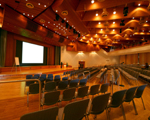Teleconferencing requires hearing the voice, so it should follow that videoconferencing requires seeing the people, right? Not so much. Videoconferencing actually requires a finer level of detail – it requires seeing the eyes. Why? We communicate with our eyes. If you cannot clearly see the eyes of the communicator, then you might as well be on a teleconference. This is why web quality video has become unacceptable for many types of corporate communication.
Even more difficult are large spaces such as boardrooms or corporate auditoriums. The size of these spaces alone presents a real challenge to the video conferencing system, making it ever more difficult to see the eyes. “So what?” you say. Well, the eventual reality is that without seeing the eyes, users will eventually avoid the technology altogether.
A large room with a large audience requires good communication and minimal distractions. Where a well-designed AVL system can overcome some of the room’s limitations, a poorly designed AVL system will amplify the short comings. When we design videoconferencing systems, the physical shape and size of the room drives many of the audio, video, and lighting choices.
Here is a list of questions to consider for your videoconferencing system requirements:
- Where is the front of the room? Is all the seating toward the front?
- Will the room be used in a variety of setups?
- Will the local presenter be seated, stand at a podium or walk around?
- Will live audience questions both local and far site need to be accommodated?
- Does the audience response need to be heard by the far sites?
- Is this a typical two way video conference, or is there a main presenter who talks to the local audience and far sites?
- Does the local large group need to see the far site person?
- Does the large group need to see local or far site content?
- Will the local content need to be shown on the same screen as the far sites?
- Will there be trained personnel to support the room?
- Can the presentation areas have broadcast lighting?
Once answered we weigh the responses against two criteria:
- What will it take to see the presenter’s eyes?
- Will that fit in the budget?
Then we progress to the AVL gear choices:
- Where can technology be installed in the room?
- Does it need to be invisible?
- Will there be operators of the equipment?
- What level of automation is required?
Again, when adding videoconferencing to a large corporate space there are a lot of factors to consider, but the greatest factor will be whether or not we can see the presenter’s eyes. At Acoustics By Design, we develop videoconferencing systems custom fit to our client’s needs. Give us a call when you’re ready to upgrade your videoconferencing system.
